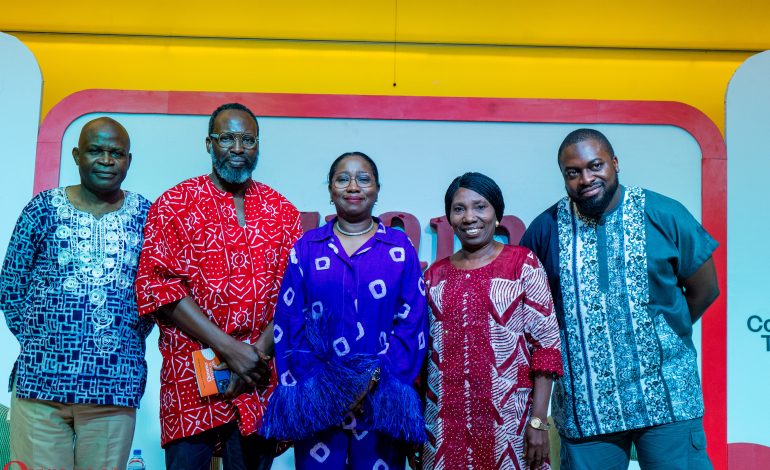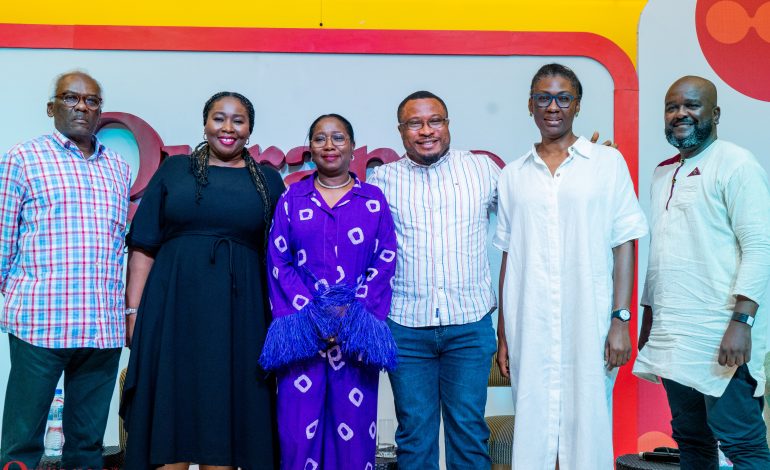Experts charge govt on infrastructure for national monuments, returned artefacts

* ‘There has to be shared custody between government and local people’
* ‘What should have been National Museum of Lagos is now City Mall’
By Godwin Okondo
ONE of the most enlightening panel sessions at Quramo Festival of Words 2023 took on ‘Ancient African Art and Culture: The Looting, Return and Preservation’. It formed part of festival’s theme, ‘Connecting the Dots’ to Africa’s past. The session brought together enthusiasts and experts for an insightful exploration of Africa’s rich cultural heritage and its current health in the imminent return of looted artefacts from across the world. Journalist and culture communicator, Mr. Jahman Anikulapo, lawyer and co-founder of Chocolate City Record label, Mr. Yahaya Maikori and a former curator at the National Museum, Onikan, Lagos, Mrs. Omotayo Adeboye. It was moderated by Fu’ad Lawal.
Adeboye spoke on the strategic locations of some Nigerian museums to palaces of kings, when she said, “We must know that the royal fathers are the custodians of our culture, and they represent father-figures in our culture. So most often, they give the space for the construction of museums. You said you went to Bénin City, and you noticed that the National Museum is close to the palace, and I know that there are so many of our museums established close to royal palaces. The kings are the custodians of the culture and they have a lot of influence on the people that they rule, and whatever culture exists in those places. It is not out of place that the museum which preserves the cultural artefacts of these people are established close to the royal fathers of those places.
“However, the National Museum in Ilorin is actually far from the emir’s palace, because when it was established, that was the space the governor at the time felt would be most appropriate for the artefacts to be kept. All my working life of 35 years was in managing the cultural property of Nigeria.”
Anikulapo shared his art journey into journalism, and how he came to report culture and the painful experience of witnessing Nigeria’s rich culture wasting away and being treated with cavalier attitude by its custodian, government.
“I started writing on the arts in 1984 when I was studying Theatre in the university, and I had a boss who was the literary editor of The Punch, and he made some of us in his group to start writing then,” Anikulapo recalled. “I joined The Guardian in 1987. I just came back from NYSC due to a riot, and I came by truck to Oshodi, and I couldn’t go back to my father’s house in Agege. I looked to my left, and there was The Guardian. So I just walked in, because I didn’t have any money to go home. When I joined The Guardian, one of the first things I wrote on was the museum. I had been sent to Jos; I served in Kafanchan, and Jos was nearby. We had to escape from Kafanchan to Jos when the riot started, and the museum was one of the safe places then.”
Anikulapo also spoke on the poor state of Nigerian museums and lamented the absence of government in spaces it is supposed to preserve for posterity, where it pays people salary to manage. He stressed that what was happening to museums across the country is evidence of a government that is not serious.

Mr. Jahman Anikulapo (left); Yahaya Maikori; Qfest Convener, Mrs. Gbemi Shasore; Mrs. Omotayo Adeboye and panel session moderator, Mr. Fu’ad Lawal
“I’m very disappointed in the museum here!” he declared. “That’s a death house, not a museum; I hope we don’t get to explain that. Some of these museums you see that are now dirty, they were structured and planned. So, it was easy for those of us who were reporters to identify with them than what we find now. Reporting on the arts made me understand the Nigerian problem. We have the Minister of Culture and Director of Museum, what do they do? If you go to the museum in Lagos, that building called City Mall is the museum. They built it and gave it to someone, who gave it to someone else for 99 years, and the museum stores all these works in that run-down building. What should have been the National Museum of Lagos is now the City Mall.
“I don’t talk about Nigerian artefacts, whether they should stay or be returned, or what should happen to them. I was talking to a friend from Germany about how Nigeria doesn’t respect the culture it claims it wants to preserve. The only thing we have, aside the church where they keep on employing and young ones can find their motivation is the arts.
“In Nigeria, there are museums in virtually every city, but how many of them are really functioning? As an arts and culture reporter, I’m a very frustrated person, so when I speak about this kind of topic, I speak in that direction. We are not serious. Maybe, we are waiting for the government, because if we make the environment conducive for people to identify with the museum, they will. I took my son to the museum in London and the only reference he makes to museum is the one in London and Germany. He never makes reference to the museum in Lagos. The only thing we could see then was the Murtala Mohammed’s car where he was killed.”
But the establishment lady, Adeboye, sharply countered Anikulapo, saying that the state of museums in Nigeria is good enough: “It’s unfortunate he (Anikulapo) felt that way. I’ve been in different fora and I heard some people actually talk about this, and I ask them one question. There’s a lot of limitations in the space the museum operates. I’ve been in the British Museum and others, and there are some factors that affect the museum here, but I also ask: when last did they visit the museum? And they say they haven’t been there in ten years.
“People still access the storage of the museum in Lagos, but it’s not accessible to everyone because of reasons of safety, but most often, when exhibitions are carried out, it’s mostly to encourage people. Those in charge now are working to upgrade the things you see in the museum. The new Director-General is so passionate and is trying to improve the facilities and make sure the exhibitions are being upgraded. Two years ago, we put up an exhibition that is comparable to any exhibition anywhere in the world. The museum is trying to see how the cultural property in our possession attracts younger people, and to inform the public about their heritage and culture.”
Maikori also shared a documentary of the famous Nok culture and the excavations going among his Nok people. He shared the inspiration behind what he does to preserve the ancient civilization of his people in Southern Kaduna.
“I’m a lawyer by training, and come from where this Nok culture is celebrated,” he said, “so at different points in my life I thought of what I could do for my people. When I was growing up and in the university, a lot of people in my village became rich by excavating the works. It was a common story among our people about people who became millionaires by exporting these works, and when you visited the village, you could see the holes left from the digging.
“I was concerned about how to help my people preserve this culture. Were we going to start going after these works all around Europe? I figured out that would be a long journey to nowhere. I have an uncle who’s the custodian of the Nok culture, and my mum is the last born. My father is a lawyer who came from a long line of blacksmiths. During the pandemic, I was watching a documentary and they said the Nok people are known for their metallurgical work, compared only to the Turkish people, and I wondered if we were tied to this iron work.
“When my kids were going to the U.S., I found out they didn’t know the meaning of the Nok. So, I told myself I had to do something, so that my great-grandchildren are able to latch onto it. We came for an exhibition, and I met a well-known historian and I said I was thinking of how we could recover these artworks which looked like a far-fetched journey. We have heard about Nok, but not from the local people. So, why can’t they talk about their culture? In less than a week, we signed an agreement, and three weeks after that we were in my village and this was during the peak of the killing in Kaduna and everyone was asking what we were doing there, but he was so passionate about the whole thing. The days I spent there changed my life, going into the caves and seeing the ancient writings, and I was transfigured. We left our professional jobs and got immersed in the story.”
Like most Nigerians who are heavily invested in the blossoming of the country’s arts and culture space, but who see the stifling apathy from government, Anikulapo couldn’t hide his frustration at government’s perennial failure to set policies that guide the country’s cultural space.
“When I said we are not serious, the temperament of a reporter is different from an administrator,” he said. “Reporters have the opportunity of seeing quite a lot, and we are not interested in all these individual stories of the DG. We are looking at policies. Where are the policies guiding the museum? The same way gold is mined in Zamfara is the same way artefacts are mined in this country without consequences.
“We need to go round and see the state of museums in Nigeria, up to the point that most of the people are being paid and there’re no results. You need to ask yourself: what is going on in these museums? We raised two million dollars to build a Conservatory at the Lagos museum, and that was why they moved Mohammed’s car to the back, and we didn’t even know the Yoruba History Museum was coming. What happened to the money? The DG then said the money should be paid into the Nigerian government’s account or they would not build it, and the money should be spent on all the museums in Nigeria. We were still on that when that money was diverted to Timbuktu, Mali.
“I’m painting the picture of the environment. The seriousness has to come from the policy. What is the DG doing aside trying to recover the artworks? There’s no national museum befitting of the name. The first major story I wrote was on the National Cultural Policy, and they are still trying to get it up till now. We want those artworks to come back, but on what basis? Where are the works coming to? Those works cannot go to that National Museum in Lagos, because it is a storage. If some of those works come back and we don’t have a place to exhibit them, they will be stolen again.
“A system without a cultural policy is like a country without a constitution. I symphatise with the people who have worked there over the years. If you stage an exhibition at the National Museum in Lagos, do you know they don’t have access to the money you pay? The money goes to Abuja, and money is allocated from there. I used to run the Lagos Book and Art Festival at the National Museum, and we even installed the AC. The landscape is not encouraging, and that’s why I said we are not serious. Are we going to have a proper inventory of those works being returned? Look at the Yoruba History Museum that is locked up and the materials there going bad.”
Using the Nok culture as example of a lack of seriousness of those managing artefacts in the country Maikori said, “while we were shooting the documentary, we went to the Nok Museum and there wasn’t a single work there, just pictures, despite all the excavations and shipping that was going on. There’s nothing there to depict this African culture. Most museums have moved the works into storage because of the agitation from the people. It’s very important to get local people involved in this process. We have a museum in Lagos, and Lagos has close to three million visitors every year. Yet, there are no exhibitions being held. There has to be shared custody between the government and the local people, and we need to review the cultural policy to involve the local people in the process.”
Adeboye stressed the importance of retrieving the artefacts scattered all over Europe, arguing that this was imperative because they are tied to the people’s history and culture, “We should not forget that those artefacts are tied to the history and culture of the people. The 160 Benin heads are objects cast after past Obas of Benin. If those objects are tied to the chronological records of the history of Benin, and you’re asking where we would keep them, you are saying we shouldn’t bring them back and cause a distortion in history.
“I visited the British Museum and I saw a terracotta head and I talked about bringing them back and they said the temperature and humidity may not be okay. I told the curator that those objects were taken from Nigeria and the temperature was favourable before they were carted away. Most of these objects are mostly kept in shrines and the temperature then was favourable. Those objects are tied to our history and those people don’t want that gap in our history, and if we want them back, a place to keep them will be provided.”
On the issue of lack of storage for the artefacts, Anikulapo made a clarification, explaining the need to have a place to keep them first, since rushing to have them back would create storage problems and even triggered those charged with managing them relooting and selling back to Europe again.
“I am not saying the works should not come back,” he explained. “The analogy I’m giving is like someone who wants to rent a house and he starts buying furniture and piling them somewhere and he doesn’t have a house, and by the time he finds one, the furniture are rotting in the rain. Let’s be prepared. There’s no rush. Let us get the structures ready first. Nigeria does not have a central national museum or a national theatre, so where do we keep them? The first thing is to decentralize — let every state take control of their own museums.
“It can be in partnership with the National Museum, so everything isn’t kept in one place and you want people to travel. When the Yoruba History Museum was being built, they wanted to link it to the National Museum with a bridge, but they had to stop it because of this law of putting the money in the federal government account. The solution is to go individual. Look at the Yemi Shyllon Museum at Pan Atlantic University; people love to go there, because its in good shape. We can make the National Museum look that good to attract visitors and make good money.”



